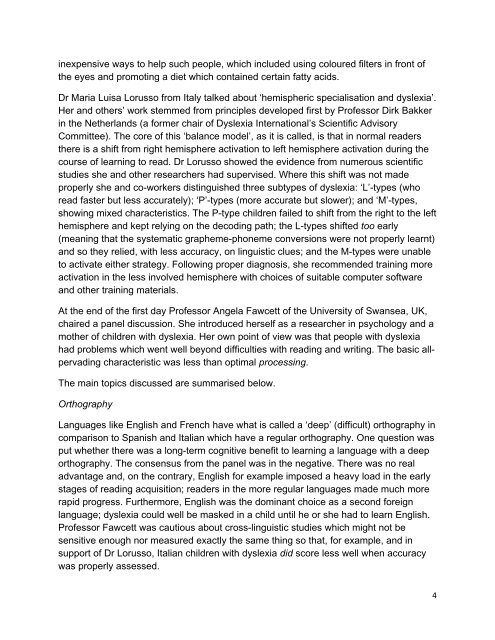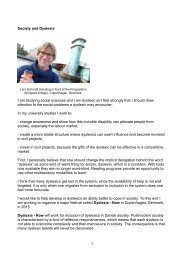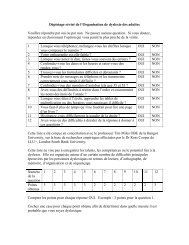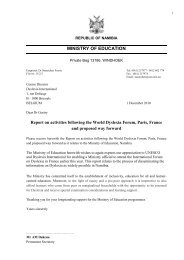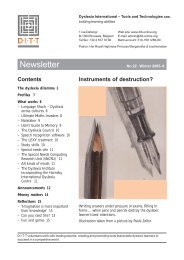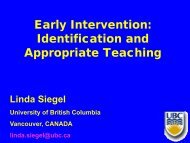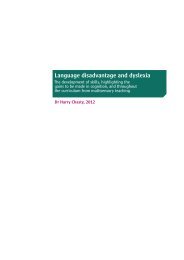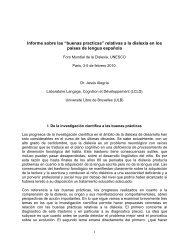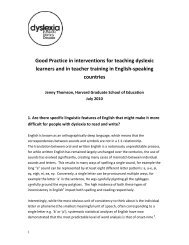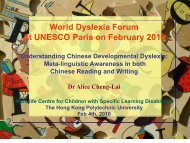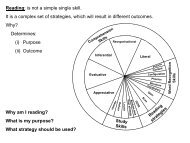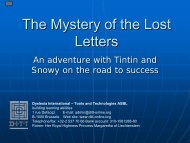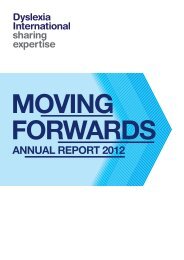World Dyslexia Forum, 3 â 5 February 2010, UNESCO, Paris
World Dyslexia Forum, 3 â 5 February 2010, UNESCO, Paris
World Dyslexia Forum, 3 â 5 February 2010, UNESCO, Paris
Create successful ePaper yourself
Turn your PDF publications into a flip-book with our unique Google optimized e-Paper software.
inexpensive ways to help such people, which included using coloured filters in front ofthe eyes and promoting a diet which contained certain fatty acids.Dr Maria Luisa Lorusso from Italy talked about ‘hemispheric specialisation and dyslexia’.Her and others’ work stemmed from principles developed first by Professor Dirk Bakkerin the Netherlands (a former chair of <strong>Dyslexia</strong> International’s Scientific AdvisoryCommittee). The core of this ‘balance model’, as it is called, is that in normal readersthere is a shift from right hemisphere activation to left hemisphere activation during thecourse of learning to read. Dr Lorusso showed the evidence from numerous scientificstudies she and other researchers had supervised. Where this shift was not madeproperly she and co-workers distinguished three subtypes of dyslexia: ‘L’-types (whoread faster but less accurately); ‘P’-types (more accurate but slower); and ‘M’-types,showing mixed characteristics. The P-type children failed to shift from the right to the lefthemisphere and kept relying on the decoding path; the L-types shifted too early(meaning that the systematic grapheme-phoneme conversions were not properly learnt)and so they relied, with less accuracy, on linguistic clues; and the M-types were unableto activate either strategy. Following proper diagnosis, she recommended training moreactivation in the less involved hemisphere with choices of suitable computer softwareand other training materials.At the end of the first day Professor Angela Fawcett of the University of Swansea, UK,chaired a panel discussion. She introduced herself as a researcher in psychology and amother of children with dyslexia. Her own point of view was that people with dyslexiahad problems which went well beyond difficulties with reading and writing. The basic allpervadingcharacteristic was less than optimal processing.The main topics discussed are summarised below.OrthographyLanguages like English and French have what is called a ‘deep’ (difficult) orthography incomparison to Spanish and Italian which have a regular orthography. One question wasput whether there was a long-term cognitive benefit to learning a language with a deeporthography. The consensus from the panel was in the negative. There was no realadvantage and, on the contrary, English for example imposed a heavy load in the earlystages of reading acquisition; readers in the more regular languages made much morerapid progress. Furthermore, English was the dominant choice as a second foreignlanguage; dyslexia could well be masked in a child until he or she had to learn English.Professor Fawcett was cautious about cross-linguistic studies which might not besensitive enough nor measured exactly the same thing so that, for example, and insupport of Dr Lorusso, Italian children with dyslexia did score less well when accuracywas properly assessed.4


